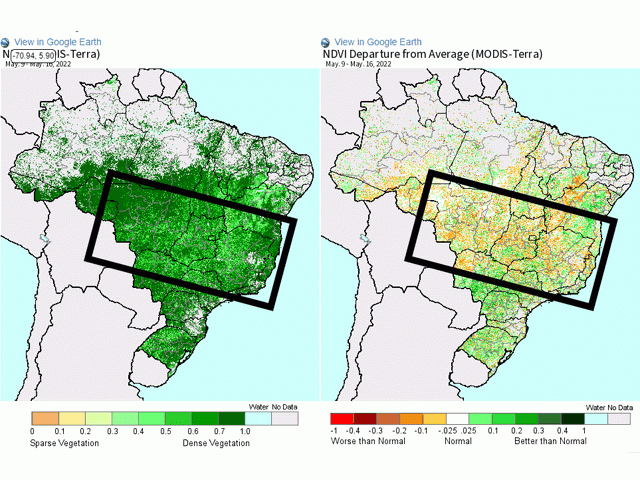South America Calling
Safrinha Corn's Time Almost Up in Central Brazil
Early planted second-season (safrinha) corn in Mato Grosso, Brazil's highest production state, is starting to be harvested. According to the Mato Grosso Institute of Agricultural Economy (IMEA), 1.24% of the state's crop has been harvested as of May 20. It has been a tough season for corn in this state extending into Goias and Minas Gerais as well. The three states combined typically account for about 60% of safrinha corn production in Brazil. And these areas have been under threat of drought going back to early April on the whole and March in parts of these states.
I have written about it extensively, but La Nina caused an early start to the dry season by more than two weeks officially. But for some areas, good rains have not fallen since sometime in March. It has been a complete turnaround from the first-crop soybean season that was characterized as being wet-to-too-wet for the entire season. Soil moisture profiles were full and rains were falling when seed was being planted in late January into February. IMEA estimated that about 90% of the corn crop was planted within the ideal planting window that closes at the end of February despite the rains. That window is for a typical season with a typical end to the wet season in early May. But it was dry by the April 18 for the 2022 year and almost no rain has fallen since.
Brazilian farmers take chances with the climate to produce a first crop soybean and safrinha crop corn within the same year. Double-cropping corn and soybeans is an ambitious and lucrative goal that comes with incredible risk, hinging on the behavior of the wet season. When it behaves, great profit can be made. When it does not, disaster can strike one or the other, or both seasons.
P[L1] D[0x0] M[300x250] OOP[F] ADUNIT[] T[]
The wet season usually starts in late September and finishes up in those first few days of May. That provides ample moisture throughout the soybean season and gives safrinha corn the likelihood of reaching grain-fill before the rains shut down, leaving the crop with plenty of subsoil moisture to finish out a good crop. It definitely started out that way with rains starting almost on the exact average start date around Sept. 26. That gave soybeans a good footing and yields only fell short of expectations because of reported cases of increased disease pressure and lack of sunshine from all the rain. But the quick end to the rains have made it a disaster for corn.
Being so close to the tropics, heat has also been an issue. Temperatures routinely move up into the lower 30s Celsius (middle 80s or lower 90s Fahrenheit). But many days have reached above the normal marks, with some instances of near 40 C (104 F) mixed in there. Through mid-March, the early-developing crop looked great, but afterward, declining soil moisture has been noticeable.
Normalized Difference Vegetation Index (NDVI) is a satellite derived product that shows the "greenness" of vegetation. That is an indicator of crop health. The lower the returns to the satellite, the less leaf area and active chlorophyll are in the area. That could be due to disease, drought, less vegetative vigor, or other factors, but none of these are good signs for crops. In the attached image on the right, it is easy to see that the states of Mato Grosso, Goias, and Minas Gerais are all suffering with widespread below-normal "greenness" shown by the brown shading. Very few areas are green that would indicate good crop health.
The reverse is true over southern Brazil's crop areas. The large areas of green indicate that safrinha corn and early wheat are in much better health than the crop to the north. Good production from that safrinha corn crop is being counted on to make up for some of the reductions in central Brazil. But these states only account for about 30% of the total production. It cannot make it all up.
A frontal boundary has stalled across southern Brazil and will waffle around between the states of Mato Grosso do Sul-Sao Paulo down through Rio Grande do Sul through next week. Waves of showers will move through, but not reach up into the highest production areas from Mato Grosso to Minas Gerais. Those areas will have to do without as they move toward maturity.
Incentives for growing safrinha corn have never been higher in Brazil and production areas are forecast by the National Supply Company (Conab) in Brazil to increase from roughly 15 million hectares (37 million acres) in the 2020-2021 season to 16.6 million hectares (a little over 41 million acres) in this season. That is an increase of over 10% from last year. The increased area, even with lower production, will also make up for some of the production. When combined, Conab is still suggesting total corn production at 114.6 million metric tons (mmt) easily a new record. The USDA has forecast 116 mmt. Crop production on a ton per hectare or bushel per acre basis is likely to be down below trend and certainly below where expectation were at the start of the safrinha season, but production is still expected to be high and compete for more export business than last season.
To find more international weather conditions and your local forecast from DTN, head over to https://www.dtnpf.com/….
John Baranick can be reached at john.baranick@dtn.com
(c) Copyright 2022 DTN, LLC. All rights reserved.





Comments
To comment, please Log In or Join our Community .